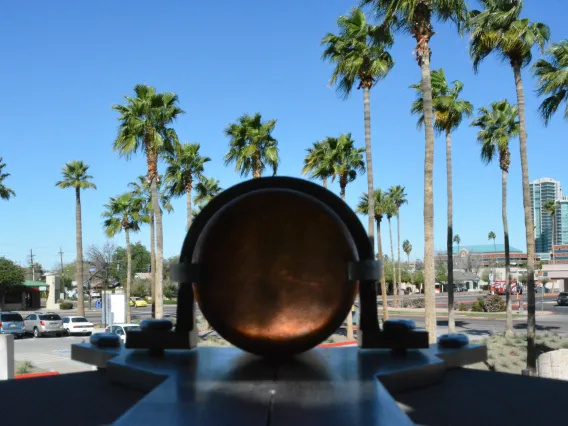Deep Time Photography
Deep Time Photography is an art-and-science project by Jonathon Keats, aiming to photographically document the next thousand years of environmental change in the Sonoran Desert and beyond.
The project enlists a new approach to photography based on the traditional pinhole camera. Pierced through a thin sheet of gold, a minuscule pinhole focuses light onto colored pigment, such that the color fades most where the light is brightest, very slowly imprinting a unique positive image. The thousand-year-long photographic exposure not only shows the view in front of the camera, but also records how the viewshed shifts over time, revealing dynamics ranging from urban development to climate change. By these means, Deep Time Photography complements and expands upon the more-than-hundred-year history of repeat photography in the Sonoran Desert.

Millennium Camera
Sibila Savage
While one goal of Deep Time Photography is to provide documentation of human and environmental dynamics for study by future generations, each of Keats’ hand-built millennium cameras is equally intended as a mechanism for people today to envision their long-term impact on the environment – and potentially to change the picture by altering their behavior.

Millennium Camera installed on Tumamoc Hill.
Photo Courtesy of The Desert Laboratory on Tumamoc Hill
In partnership with the University of Arizona Desert Laboratory and the University of Arizona College of Fine Arts, Keats will deploy several millennium cameras on Tumamoc Hill between the years 2023 and 3023. The cameras will be positioned to provide an expansive view of Tucson, and to present multiple opportunities for the public to engage in deep-time thinking as they explore the region. These cameras, the first of which was recently sited at the midpoint of Tumamoc Hill adjacent to the University of Arizona’s Desert Laboratory compound, belong to a larger Deep Time Photography network. Other cameras have been installed at Arizona State University (overlooking the rapidly-expanding city of Tempe), at Amherst College (overlooking the forested Holyoke Range), and on Lake Tahoe (overlooking the Sand Harbor State Park).
The questions provoked by Deep Time Photography are simultaneously urgent and timeless. Over the next thousand years, the network of millennium cameras will keep the future in focus.
This project is made possible by Arizona Institute for Resilience, the Desert Laboratory on Tumamoc Hill, and the College of Fine Arts at the University of Arizona. Funding is provided by the Technology Research Initiative Fund/Water, Environmental, and Energy Solutions Initiative (TRIF-WEES).





